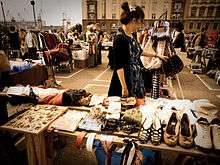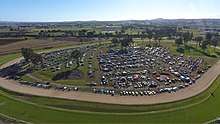Flea market



A flea market (or swap meet) is a type of bazaar that rents or provides space to people who want to sell or barter merchandise. Used goods, cheap items, collectibles, and antiques are commonly sold. Many markets offer fresh produce or baked goods, plants from local farms and vintage clothes. Renters of the flea market tables are called vendors. It may be indoors, as in a warehouse or school gymnasium; or outdoors, as in a field or parking lot or under a tent. Flea markets can be held annually or semiannually, others may be conducted monthly, on weekends, or daily. Flea-market vendors may range from a family that is renting a table for the first time to sell a few unwanted household items, to scouts who rove the region buying items for sale from garage sales and other flea markets, and several staff watching the stalls.[3][4][5]
Flea market vending is distinguished from street vending in that the market itself, and not any other public attraction, brings in buyers. Many flea markets have food vendors who sell snacks and drinks to the patrons.[6] Some flea market vendors have been targeted by law enforcement efforts to halt the sale of bootleg movies and music[7][8] or knockoff brand clothing, toys, electrical goods, accessories, or fragrances.
Regional names
Different English-speaking countries use various names for flea markets. In Australian English, they are also called 'trash and treasure markets'. In Philippine English, the word is tianggê from the Nahuatl tianguis via Mexican Spanish (despite common misconception, it is not derived from Hokkien),[9] supplanting the indigenous term talipapâ.[10] In India, it is known as gurjari or shrukawadi bazaar or even as juna bazaar (in Pune) .. In the United Kingdom, they are known as "car boot sales" if the event takes place in a field or car park, as the vendors will sell goods from the 'boot' (called "trunk" in American English) of their car. If the event is held indoors, such as a school or church hall, then it is usually known as either a "jumble sale", or a "bring and buy sale". In Quebec and France, they are often called Marché aux puces, while in French-speaking areas of Belgium, the name Brocante or vide-grenier is normally used. In German there are many words in use but the most common word is "Flohmarkt", meaning literally "flea market". In the predominantly Cuban/Hispanic areas of South Florida, they are called [el] pulgero ("[the] flea store") from pulga, the Spanish word for fleas. In the Southern part of Andalusia, due to the influence of Gibraltar English, they are known as "piojito", which means "little louse"
Etymology

While the concept existed in places such as what are now India, Bangladesh, and China for millennia, the origins of the term "flea market" are disputed. According to one theory, the Fly Market in 18th-century New York City began the association. The Dutch word vlaie (also spelled vlie, meaning "swamp" or "valley") was located at Maiden Lane near the East River in Manhattan.[11][12] The land on which the market stood was originally a salt marsh with a brook, and by the early 1800s the "Fly Market" was the city's principal market.[13]
Another theory maintains that "flea market" is a common English calque from the French marché aux puces (literally "market of the fleas").[14] The first reference to this term appeared in two conflicting stories about a location in Paris in the 1860s which was known as the marché aux puces (flea market).
The traditional and most-publicized story is in the article "What Is a Flea Market?" by Albert LaFarge in the 1998 winter edition of Today's Flea Market magazine: "There is a general agreement that the term 'Flea Market' is a literal translation of the French marché aux puces, an outdoor bazaar in Paris, France, named after those pesky little parasites of the order Siphonaptera (or "wingless bloodsucker") that infested the upholstery of old furniture brought out for sale."
The second story appeared in the book Flea Markets, published in Europe by Chartwell Books, has in its introduction:
In the time of the Emperor Napoleon III, the imperial architect Haussmann made plans for the broad, straight boulevards with rows of square houses in the center of Paris, along which army divisions could march with much pompous noise. The plans forced many dealers in second-hand goods to flee their old dwellings; the alleys and slums were demolished. These dislodged merchants were, however, allowed to continue selling their wares undisturbed right in the north of Paris, just outside the former fort, in front of the gate Porte de Clignancourt. The first stalls were erected in about 1860. The gathering together of all these exiles from the slums of Paris was soon given the name "marché aux puces", meaning "flea market", later translation.[15]
Image gallery
 Wolff's Flea Market in the United States
Wolff's Flea Market in the United States- Flea market in Japan
.jpg)

 Flee market (Leiden, end of the 19th century)
Flee market (Leiden, end of the 19th century)
See also
- Braderie
- Car boot sale
- Charity shop
- Farmers' market
- Garage sale
- Hamfest
- MASP Antique Market
- Pasar malam
- White elephant sale
References
- ↑ "Beaudesert Motoring Enthusiasts Club". Beaudesert Motoring Enthusiasts Club. Retrieved 2017-07-26.
- ↑ "Beaudesert Swap Meet & Static Vehicle Display". Beaudesert Swap Meet & Static Vehicle Display. Retrieved 2017-07-26.
- ↑ "Flea market". Dictionary.com. 1998. Retrieved February 12, 2012.
- ↑ "What is a flea market?". Conjecture Corporation. Wisegeek.com. 2003. Retrieved February 12, 2012.
- ↑ "Americana Resources Inc. (2008, October 20)". Flea Market Directory – Uniting the Many Worlds of Collecting. Collectors.org. Retrieved February 12, 2012.
- ↑ "How to Become a Flea Market Vendor". StyleCareer.com. Afton Institute, LLC. 2008. Retrieved 2008-09-13.
- ↑ Mitchell, Bob (August 21, 2007). "Police bust nets $800K in pirated DVDs". TheStar.com. Toronto Star. Retrieved September 13, 2008.
- ↑ Roberts, Bob (December 17, 2005). "Swap-O-Rama Raid Spoils Christmas Shopping For Bootleg Recordings". WBBM Newsradio 780. CBS Radio. Retrieved September 13, 2008.
- ↑ Hernández, Paloma Albalá (2007). Americanismos en las Indias del Poniente: Voces de origen indígena Americano en las lenguas del Pacífico. Lingüística Iberoamericana. IX. Vervuert. p. 171. ISBN 9788495107527.
- ↑ "Tagalong Lang". Tagaloglang.com. Retrieved 2013-02-09.
- ↑ "History Blog Insight into History – A Weekly Instrospective Into The Past". Archived from the original on 21 March 2012.
- ↑ "Flea Markets in Arkansas". Arkansas Arts and Crafts. Arkansas Department of Parks & Tourism. 2006. Retrieved 2008-10-11.
- ↑ Google Books: The geographical and historical dictionary of America and the West ..., Volume 3, by Antonio de Alcedo and George Alexander Thompson, p. 409, 1812
- ↑ flea market. The American Heritage Dictionary of the English Language: Fourth Edition, 2000
- ↑ Prieto, J. (2007). "Flea Market History". Hollis Flea Market. Retrieved February 12, 2012, from http://www.hollisflea.com/flea_market_history.html
External links
| Wikimedia Commons has media related to Flea markets. |
